Cape Evans at Last
by Francesca Eathorne
Blog number five from the Trust’s General Manager Operations and Communications on her first experience of Antarctica.
For Francesca’s previous posts, please see the Antarctic Blog feed.
I wake up nervous. A sort of excited nervous really. Today is the day we head out to Cape Evans. For me, it’s five days of camping out at a field camp. I’m feeling ready for an adventure and to get off base.
We have spent days moving gear and packing and repacking. Everything is weighed and gets packed into two large blue cubers that will be dragged behind our Hagglund. Al and Nic will be going on to do the monitoring and maintenance run at Shackleton’s hut at Cape Royds after Evans so they need to sling their gear in via a helicopter. There is much weighing of gear and people to get the loads right for the helo.
After an extensive health and safety briefing our group of seven pile into the Hagglund and we are away.
Sam, our field support and Hagglund driver, tells us it will take about three hours for us to reach camp but if conditions are good we may make some stops along the way. I get the prime spot in the front Hagglund sitting in the middle seat. I have unobstucted views out the front. This is worth the slight logisitical difficulty of having nowhere to put your legs but cocked in front of you as straight as you can manage, amongst the gear. The side windows in a Hagglund tend to get packed with ice crystals after five minutes of travel so there’s not much to be seen.
It’s a bluebird day, with clear blue skies. Mt Erebus is stunning today. Everyone keeps commenting on how good the weather is and how unrestricted the views are. In order to get to Cape Evans, the site of Captain Scott’s second expedition to Antarctica, known as the British Antarctic Expedition (or sometimes the Terra Nova Expedition, after the ship’s name), we have to travel a long way out on the sea ice and work our way around the Erebus Glacier tongue.
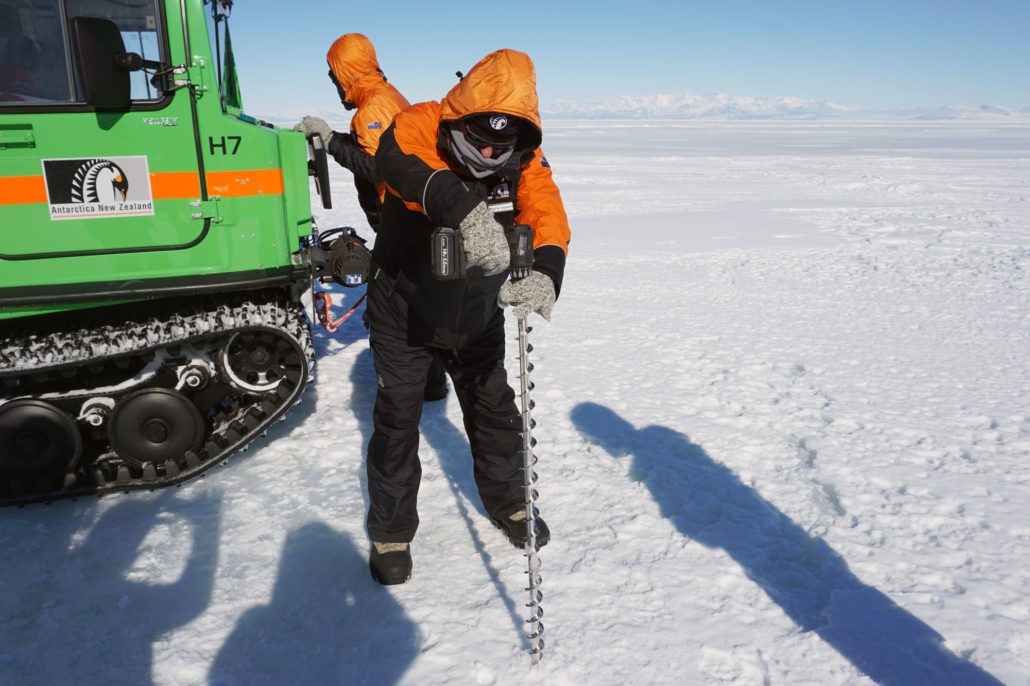 Antarctic Heritage Trust
Antarctic Heritage Trust Drilling to test the ice thickness is adequate for safe travel en-route to Cape Evans.
It’s been a dream of mine to go to the Erebus Glacier tongue and possibly even visit one of the spectacular ice caves that have formed there. Early explorer and photographer Herbert Ponting took an iconic image of the Terra Nova ship from within an ice grotto somewhere in this same region. I have this image hanging in my study at home and it’s glorious. Antarctican Anthony Powell’s photos inside ice caves have always inspired me as well.
Our first stop is at Turtle Rock. It’s nice to stretch our legs. We are reminded to hold on to our hats, gloves and other loose items as these things tend to blow away quickly. The wind is cold but we are all so excited about the views that no-one cares. Sam and Al drill down into the sea ice to check the levels. Sam explains that the Hagglund needs at least 75cm of ice thickness for them to safely travel. He measures it at 147cm so that is good news.
I remember reading in my great-uncle Leon’s memoirs that one season a US vehicle broke through the sea ice and sank, with the loss of one person. Apparently from then on they would wait for the Kiwis to cross the sea ice before heading out. They hand drilled the ice to check its depth requiring it to be two feet or more thick. One time a spot measured only three inches. Leon says “we crept back to the vehicle and returned to base, to wait a few days for the ice to thicken”. Soon the sea ice will melt and driving out to Cape Evans will not be possible. The only way then will be by helicopter. It’s already not possible to travel overland to Cape Royds.
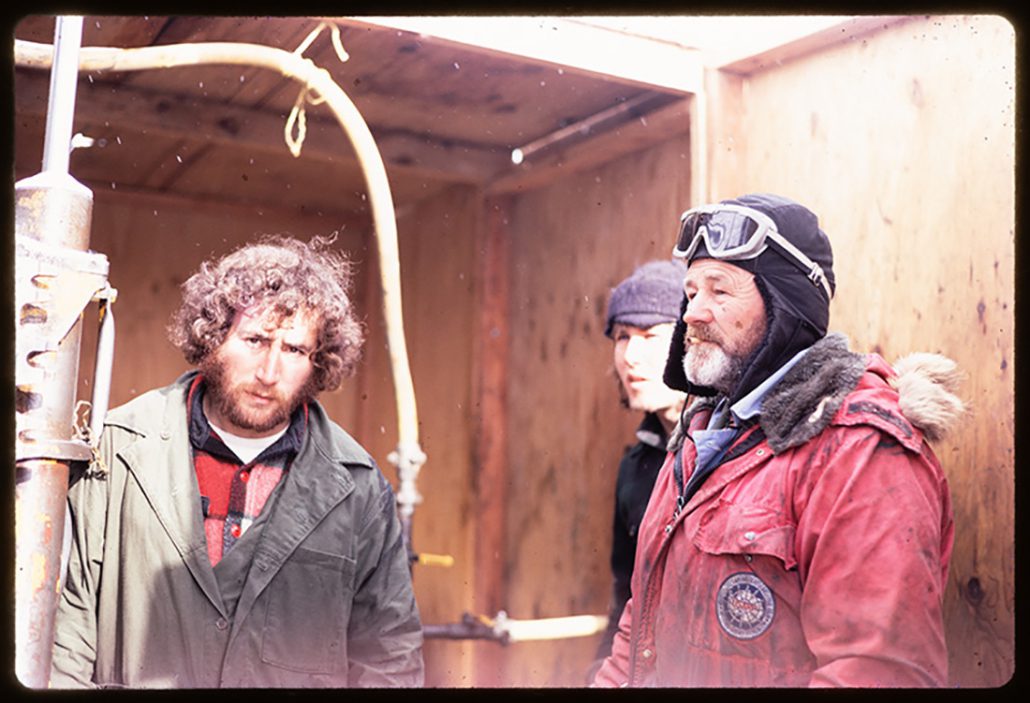 Michael Wing
Michael Wing Francesca’s great uncle Leon Oliver (in red jacket).
Another ten minutes down the ice road and we can clearly see the Erebus Glacier tongue (or EGT as the locals call it). It’s stunning. Towering ice shimmering in the light both white and blue at the same time. Sam discovers an ice cave that he thinks is safe for us to explore. It’s a one person at a time job. Up you go on a steep ridge into the small entrance to the cave. Al cuts steps in the ice to make it easier for me to navigate. I get to the top and peer into this incredible space. The ice crystal formation is unreal. I’m scared about getting into the cave as it’s a steep descent and I’m worried I won’t be able to get out easily. The cumbersome gear we wear makes it hard to move. I feel restricted in stretching my legs out to securely get my footing. Sam says I can just sit at the top. He helps me navigate into position. However, once I am there, just inside the lip of the cave, I realise I can easily slide my way down into the cave itself. I am so glad I did. It’s pure majesty standing in the cave. Sam recommends only speaking quietly, perhaps so loud voices don’t dislodge any fragile ice. But it also seems like the reverant thing to do. Quite simply, this is one of the best things I have done in my life; exploring an ice cave in Antarctica, even if it’s only for five minutes!
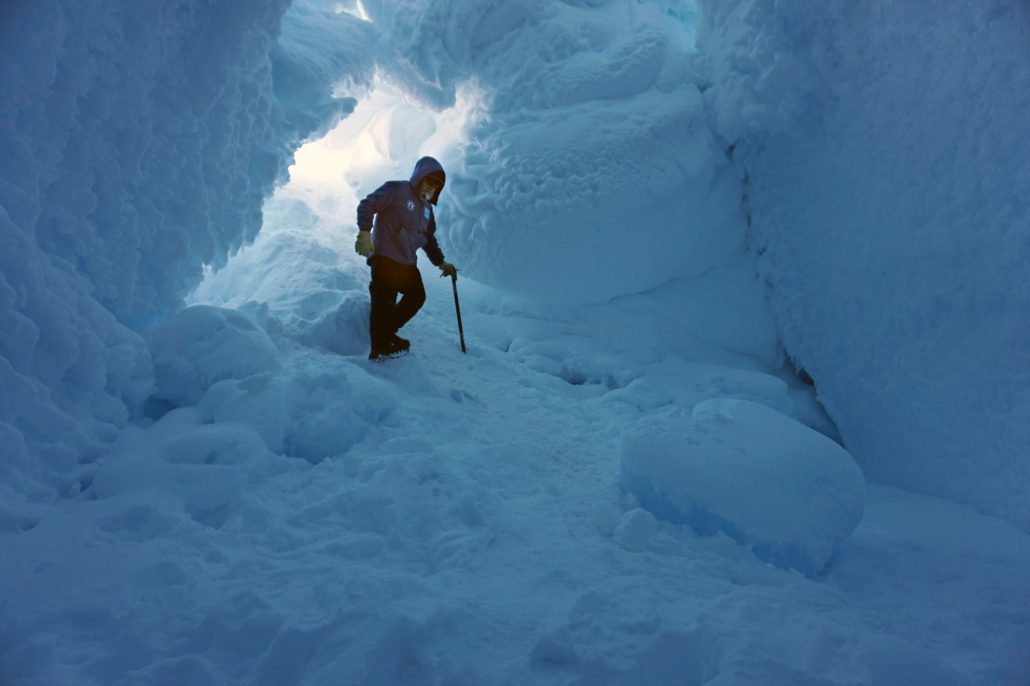 Antarctic Heritage Trust
Antarctic Heritage Trust Al Fastier descending into the ice cave n the Erebus Glacier tongue.
The colours in the cave are a wash of blue and white but it’s all translucent so the reflections draw you in. The cave pinches back to another small chamber hidden behind a curtain of ice crystals. I don’t go in there but peer under the sheet of ice and it gives me shivers to see the cave disappearing back into the glacier.
After we climb out of the cave (not a problem in the end) Al advises me the best way to get down the steep slope is to bum slide. It reminds me of the story of Shackleton, Worsely and Crean who employed a similar technique on the last part of their epic crossing of South Georgia. Al, Nicola and I bum slide down the slope, which is great fun and feels like a fitting end to exploring an ice cave.
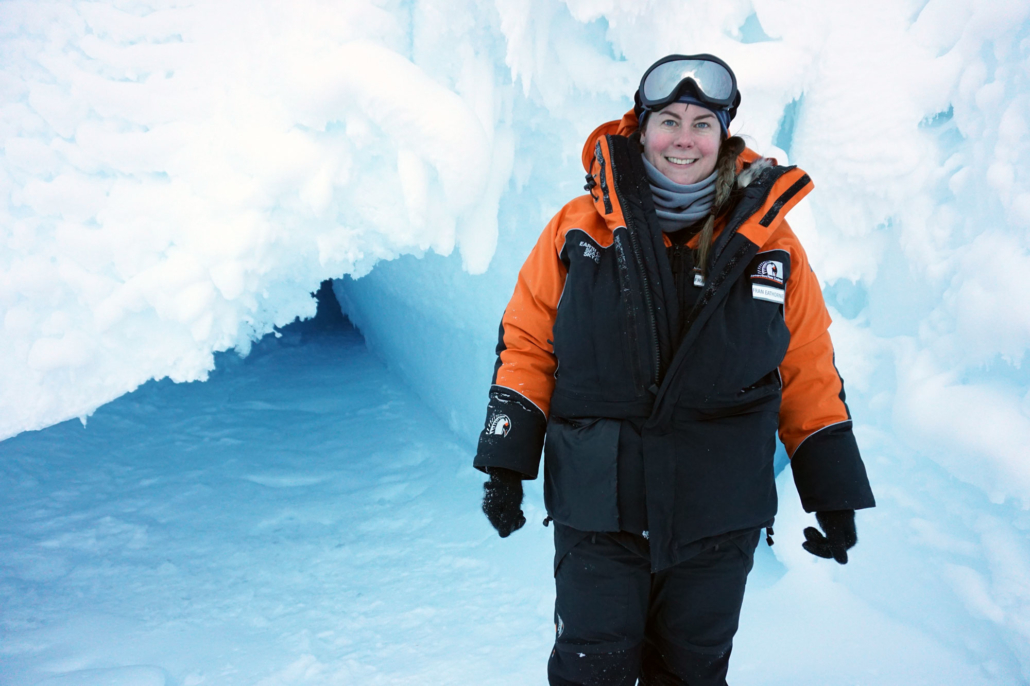 Al Fastier
Al Fastier Francesca inside the ice cave on the Erebus Glacier tongue.
Back into the Hagglund and everyone is hyped up talking about how brilliant the experience was. The views continue to be spectacular. Sam points out Razorback Island and Little Razorback Island—two rocky outcrops jutting up from the otherwise seamless ice sheet.
Next we stop to say hi to a team of American scientists who are studying seals. They are in their pop-up pod having a warm drink. Their furry subjects are lolling about in the background. All of a sudden a lone Adelie penguin appears. It’s waddling furiously towards us, skidding on the sea ice from time to time. We make a joke the penguin wants to hitch a ride in our Hagglund, but at the last minute it changes course and heads towards the seals.
A few more ice measurements (now we are at 95cm) and we continue on for Cape Evans. Sam points out the Barne Glacier, which we now see proudly protruding out on to the ice shelf. It’s huge. It’s towering cliffs of ice sparkle in the late afternoon sun and I’m overwhelmed at the beauty of this place.
Suddenly we round a corner and arrive at Cape Evans. Named for Scott’s second-in-command Teddy Evans. The hut isn’t immediately visible but our yellow tent camp is.
We have absolutely lucked out. Not only is it a beautiful day from a weather point of view, but a departing media team have left us their tents so we don’t have to set them up. I was dreading tackling the polar dome tent again after my Antarctic Field Training experience! Not only that but Sam is able to drive the Hagglund over the tide crack safely meaning we don’t have to unload our gear on the ice and lug it up the hill piece by piece.
The first thing to do when you get to camp, according to Al, is to ‘take five and have a cuppa tea’. Years ago when the Antarctic Heritage Trust team were initially conserving Scott’s hut they built a double shipping container shelter that housed a small kitchen and dining area. This is still on site so it means there is a place to warm up as well as cook inside. In Antarctica this is pure luxury! We crowd in and eat some of the delicious food packed from the Scott Base kitchen and cradle a hot beverage.
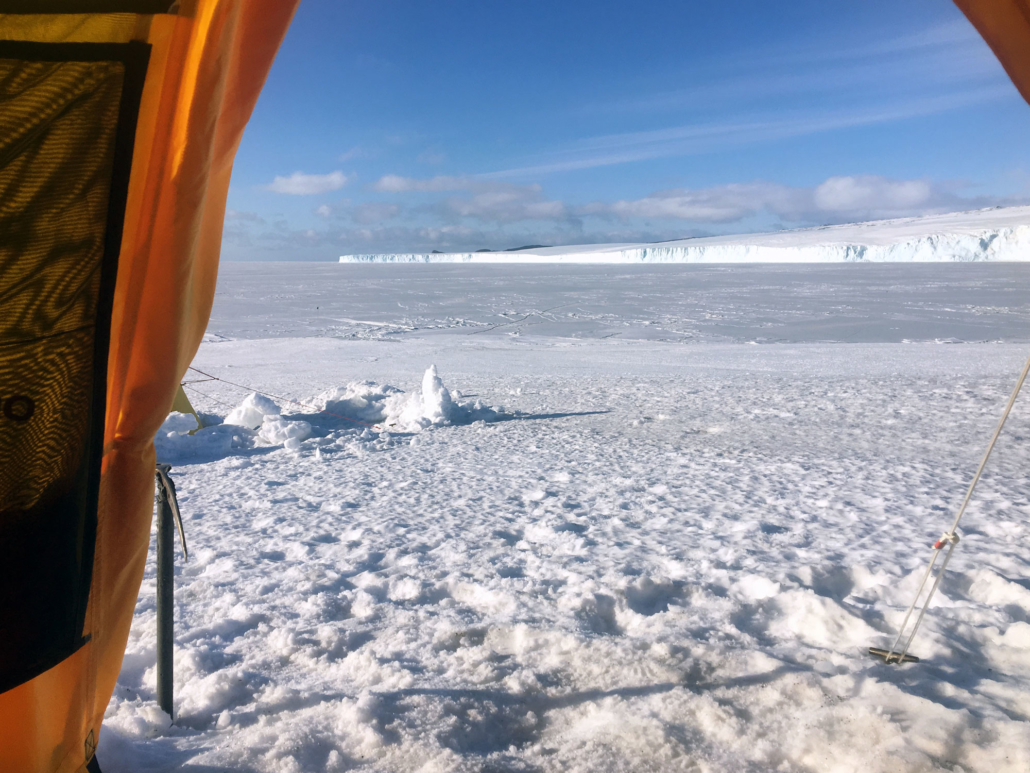 Antarctic Heritage Trust/Francesca Eathorne
Antarctic Heritage Trust/Francesca Eathorne Francesca’s view from her tent at camp at Cape Evans.
It feels great to be here. The views out to the ice shelf and the Barne Glacier are one of a kind and mesmerising. I’m sitting near the sliding glass doors at the front of the container and just can’t stop staring at this force of nature. I knew the Barne Glacier was here but had not anticipated that we would be staring straight at it. Guarding over us is Mt Erebus—the whole mountain can be seen today, with Scott’s hut a footnote at its base.
After warming up, the next priority is shelter so we all head to our tents and stuff our sleeping sacks and extra gear in, telling ourselves we will sort it out later.
Sharing our camp site with us are nine scientists working out on the sea ice. There are six different nationalities on the team and they have been based out here for some weeks. They are in their final few days on camp and, like us, after various delays this season will be making the most of their time here.
We will share the cooking space so we quickly work out a schedule for food that means we can work it in shifts. We all try to get our heads around where things are stored (it’s a tight space) and the proper ettiquette for moving around.
Since it’s been such a quick camp set up Al decides we have time to visit Scott’s Terra Nova hut before dinner. This is what we have all been waiting for so we scurry away to get our layers on for the short walk over the hill to the hut. We will mark out the route with green flags as is the custom here to sort safe pathways. I’ve decided not to take my camera or recording gear and just immerse myself in the first visit. I am so glad I did. (Read about my experience in the hut in the next blog.)
Later that night I head off to bed before the others. As I sit in my tent taking off my snow-encrusted boots I gaze out at the Barne Glacier standing there stoically and decide that this iconic view makes camping worthwhile. Tomorrow is my birthday and when I wake up the first thing I will see when I zip open my tent is the Barne Glacier and Mt Erebus. My great-uncle Leon wrote about the time he saw Mt Erebus erupt one winter’s evening, which would have been spectacular but not something to wish for on this trip!


